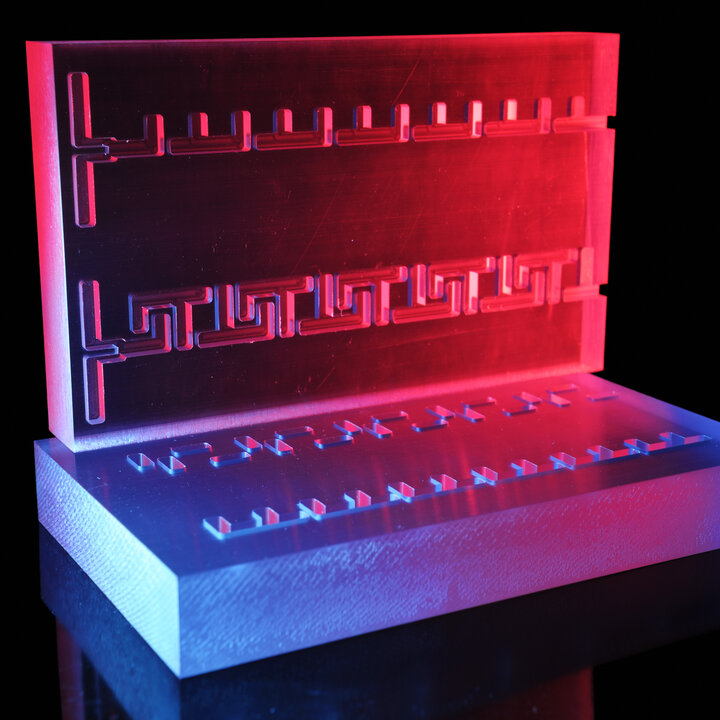
Deformation, coalescence and break-up of fluid volumes, phase separation, phase inversion and interfacial deformation solely, are important physical phenomena that determine the mechanical and optical characteristics of multi-component flow and composition. In case this flow results from an industrial process, the process conditions required and the product properties obtained, will strongly depend on these flow and composition characteristics. In addition to relevant experimental investigation, suitable physical models, together with an appropriate implementation in a numerical code, are important to obtain better understanding of the physical phenomena mentioned above. In particular we develop mapping methods and extend diffuse interface modeling.
• The mapping method (MM) for single-component fluid systems is designed to deal with the optimisation of distributive mixing flows. The model is applied to spatial- or time-periodic flows where the kinematics of the mixing process is written as a mapping between two reference grids. Classical (particle tracking) and non-classical (parallel processing) techniques are combined to construct matrices, which represent this mapping. The method is general and is successfully applied to optimise flows ranging from simple two-dimensional time-periodic prototype mixing flows to geometrically complex three-dimensional mixers.
• The diffuse-interface model (DIM) for multi-component fluid systems is derived from an elegant theory, which couples thermodynamics with hydrodynamics and results in two extra variables, the chemical potential and the composition, determined by two extra equations (a convection diffusion equation for the composition and an equation that relates the local chemical potential with the local composition of the fluid). One of the fascinating features of this model is that it combines the physical phenomena described above and, for example, is applied to study the blending of phase separating polymer systems during flow.
Applications of this work are found in chaotic mixing in microfluidics, self-stratifying coatings (phase-separation at interfaces), inkjet design for fast, accurate printing or copying, processing of organic super-fibres that outperform steel in specific strength (and modulus) by one order of magnitude, food processing, polymer blending and processing, multi-layered structures etc.
Deformation, coalescence and break-up of fluid volumes, phase separation, phase inversion and interfacial deformation solely, are important physical phenomena that determine the mechanical and optical characteristics of multi-component flow and composition. In case this flow results from an industrial process, the process conditions required and the product properties obtained, will strongly depend on these flow and composition characteristics. In addition to relevant experimental investigation, suitable physical models, together with an appropriate implementation in a numerical code, are important to obtain better understanding of the physical phenomena mentioned above. In particular we develop mapping methods and extend diffuse interface modeling.
• The mapping method (MM) for single-component fluid systems is designed to deal with the optimisation of distributive mixing flows. The model is applied to spatial- or time-periodic flows where the kinematics of the mixing process is written as a mapping between two reference grids. Classical (particle tracking) and non-classical (parallel processing) techniques are combined to construct matrices, which represent this mapping. The method is general and is successfully applied to optimise flows ranging from simple two-dimensional time-periodic prototype mixing flows to geometrically complex three-dimensional mixers.
• The diffuse-interface model (DIM) for multi-component fluid systems is derived from an elegant theory, which couples thermodynamics with hydrodynamics and results in two extra variables, the chemical potential and the composition, determined by two extra equations (a convection diffusion equation for the composition and an equation that relates the local chemical potential with the local composition of the fluid). One of the fascinating features of this model is that it combines the physical phenomena described above and, for example, is applied to study the blending of phase separating polymer systems during flow.
Applications of this work are found in chaotic mixing in microfluidics, self-stratifying coatings (phase-separation at interfaces), inkjet design for fast, accurate printing or copying, processing of organic super-fibres that outperform steel in specific strength (and modulus) by one order of magnitude, food processing, polymer blending and processing, multi-layered structures etc.
